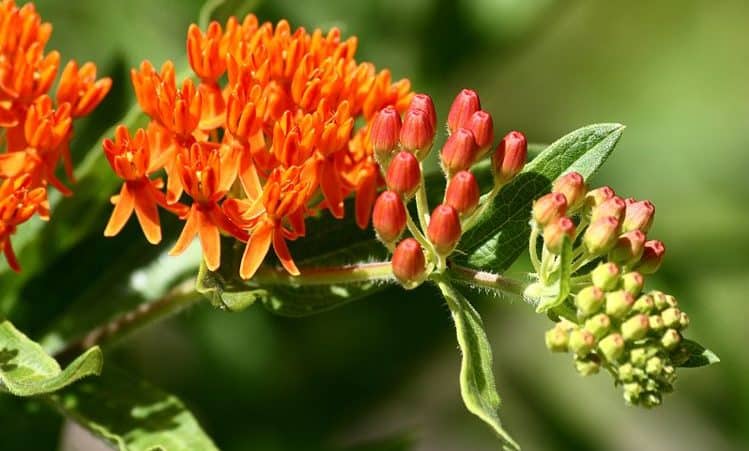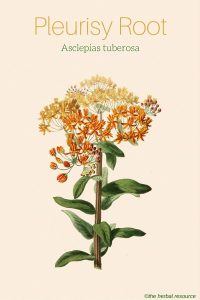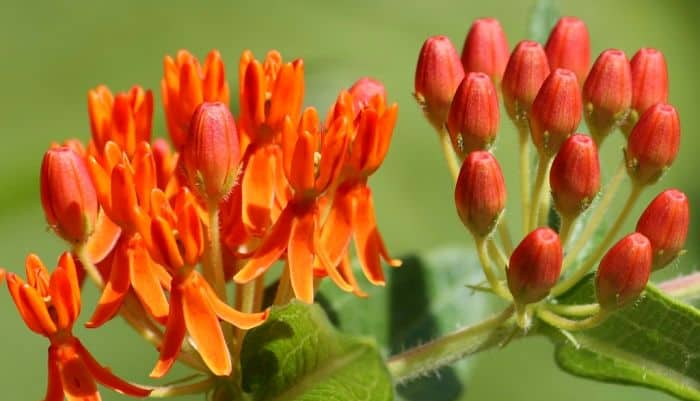Botanical Name: Asclepias tuberosa.
Other Common Names: Butterfly milkweed, butterfly weed, Canada root, chiggerflower, fluxroot, Indian paintbrush, Indian posy, orange milkweed, silkweed, silky swallow-wort, tuber root, yellow milkweed, white-root, windroot.
Habitat: Butterfly weed or pleurisy root is native to North America and is found in Ontario, Canada and throughout the continental United States except for the Pacific Northwest.
It is principally found in the Southwestern and Midwestern region of the United States.
It prefers full sun, and gravelly and sandy soils of open, dry fields, along roadsides and grassy areas.
Gardeners love this plant for its showy reddish-orange flowers which are very attractive to butterflies. Butterfly weed is also the larval food plant of the Queen and Monarch butterflies.
Description: The pleurisy root is a large, fleshy, white, spindle-shaped, and branching with a knotted crown. The plant grows in several sturdy, erect, round and hairy stems that grow to a height of 1-3 feet.
The leaves are hairy, smooth-edged and lance-shaped, growing alternately all the way up the stem. Unlike the other members of the milkweed family, Asclepias tuberosa has little or no milky sap.
The stem branches near the upper part with flat-topped umbels of numerous deep-yellow to dark orange or red-orange flowers. The flowers are hermaphrodite (having both male and female organs) and are pollinated by bees, insects, moths, and butterflies.
The flowers bloom from June through September. In the fall the 4-5 inch seed pods contain the ovate seeds which terminate in fine silky fibers. These silky fibers act as wind sails for the wind-dispersed seeds.
Plant Parts Used: The root is the medicinal part of the pleurisy root plant.

Therapeutic Uses, Benefits and Claims of Pleurisy root
Pleurisy root, or butterfly weed as it is also commonly known, is edible and medicinal, with a long history of use as a valuable medicinal herb.
It is one of the most important of the Native American medicinal plants, having been used for over a thousand years before the herb was entered in the European pharmacopeias of the eighteenth century, or listed in the United States Pharmacopoeia in the nineteenth century (1820-1920).
The Latin genus name for pleurisy root, “Asclepias” (sometimes spelled Aesclepias), is derived from the Greek god of healing Asclepius because of its value as a medicinal plant.
Pleurisy root was considered as a heal-all herb by early European settlers on the North American continent, who would have learned of its applications from the Native Americans.
Pleurisy root, or butterfly weed, is antispasmodic, carminative, mildly cathartic, diaphoretic, diuretic, expectorant, tonic and a vasodilator.
It contains cardenolides, the flavonoids rutin, and quercetin, and is estrogenic. Constituents include alpha- and beta-amyrin, resins, amino acids, volatile oil, glucosidal principal (asclepiadin), kaempferol and lupeol
It is a bitter, nutty-flavored tonic herb that increases perspiration, acts as an expectorant, and relieves spasms and it is highly valued as a traditional herbal treatment for asthma and bronchitis.
It is used by contemporary herbalists to relieve the pain and inflammation of pleurisy. Its diaphoretic and antispasmodic properties are thought to be beneficial in the treatment of pleurisy and pneumonia.
Pleurisy root, or butterfly weed, is a natural remedy used in the treatment of diarrhea, dysentery, and chronic rheumatism and its antispasmodic and carminative properties are thought to provide a natural treatment for colic, muscle tension and spasm.
Pleurisy root is traditionally used to relieve the symptoms of respiratory congestion; for this condition it combines well with cayenne, lobelia and grindelia.
Additionally, pleurisy root may be combined with ginger or lobelia as a treatment for pulmonary congestion.
It is widely used as an herbal treatment for colds, and may be used as a natural treatment for the relief of symptoms of influenza and for fever management, pleurisy root combines well with sassafras and angelica to promote perspiration.
A poultice of the roots is used topically as a natural treatment for swellings, bruises, lameness, wounds and skin ulcers.
Some Native American traditions used a body wash made of the root to enhance lifting and running strength. In some cultures, it was used as a ceremonial emetic, with ceremonious collection and distribution of the highly valued root.
The bark is used to make a quality fiber used for twine or woven into cloth. The silky seed fibers are used for stuffing in pillows, life-jackets, candle wicks and fiber for cloth.
Dosage and Administration
Twenty to sixty grains of the powdered form may be taken three times a day. 1-2 ml of the tincture may be taken three times a day.
An infusion may be made by pouring a cup of boiling water over a half to one teaspoonful of the herb, steep for 10-15 minutes. This may be drunk three times a day.
Potential Side Effects of Pleurisy Root
Pleurisy root has a long history of use as food and medicine. If the herb is used in the recommended amounts, it generally has no adverse effects.
Excessive intake can cause intestinal cramping, nausea, vomiting, and diarrhea.
Pleurisy root should be avoided by pregnant women as it may stimulate uterine contractions. It is contraindicated during lactation or for infants due to the trace amount of cardiac glycosides.
It should be used cautiously in patients with cardiovascular conditions or who are taking cardiac glycosides.
Thordur Sturluson
Latest posts by Thordur Sturluson (see all)
- What is the Difference Between Hemp and Marijuana? - June 3, 2019


Leave a Reply